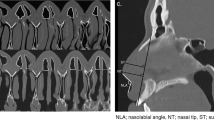Abstract
Background
Caudal septum deviation (CSD) causes functional and aesthetical problems, and conventional septoplasty techniques have still been discussed for management of CSD. This study aimed to investigate the effect of caudal chondro-mucoperichondrial flap (CCMF) to correct CSD.
Methods
A retrospective study was designed. Patients with the diagnosis of CSD were included in the study consecutively. Preoperative and postoperative first sixth and 12th month Nasal Obstruction Symptom Evaluation (NOSE) and the Rhinoplasty Outcome Evaluation (ROE) questionnaire scores, revision rates within the first postoperative year, and complication rates were identified.
Results
The mean duration of the operation was 55.9 ± 16.0 min in 77 patients. The preoperative NOSE score was detected as 10.6 ± 4.3 in all patients and decreased to 1.6 ± 1.9 in the postoperative 12th month (p < 0.001 CI: 8.2–9.7). The preoperative ROE score was detected as 6.4 ± 3.1 in all patients and increased to 18.9 ± 3.4 in the postoperative 12th month (p < 0.001 CI: 11.7–13.3). Type of CSD was detected as a significant predictor for preoperative and postoperative NOSE and ROE scores according to linear regression analysis. Revision SRP was performed in only one (1.3%) patient during 12-month follow-up.
Conclusions
CCMF is a useful alternative to management of CSD. In addition, the CSD classification developed in this study can be a useful for future studies. However, the experience of the surgical method by different surgeons will yield more meaningful results.
Level of evidence: Level IV, Therapeutic.







Similar content being viewed by others
Data Availability
There is no open repository for the data of the study, but it can be shared if asked by the responsible author.
References
Yaniv D, Hadar T, Hod R, Lansberg R, Koren I, Yaniv E (2017) Repair of caudal septal deviation: the fishing line technique. Int Forum Allergy Rhinol 7(2):211–214. https://doi.org/10.1002/alr.21863
Karadavut Y, Akyıldız I, Karadaş H, Dinç AE, Tulacı G, Tastan E (2017) Effectiveness of caudal septal extension graft application in endonasal septoplasty. Braz J Otorhinolaryngol 83(1):59–65. https://doi.org/10.1016/j.bjorl.2016.01.014
Haack J, Papel ID (2009) Caudal septal deviation. Otolaryngol Clin North Am 42(3):427–436. https://doi.org/10.1016/j.otc.2009.03.005
Sedwick JD, Lopez AB, Gajewski BJ, Simons RL (2005) Caudal septoplasty for treatment of septal deviation: aesthetic and functional correction of the nasal base. Arch Facial Plast Surg 7(3):158–162. https://doi.org/10.1001/archfaci.7.3.158
Joo YH, Cho HJ, Jeon YJ, Kim SW (2019) Use of a crossing suture to correct caudal septal deviations. Int Forum Allergy Rhinol 9(8):939–943. https://doi.org/10.1002/alr.22347
Datema FR, Lohuis PJ (2016) The tongue-in-groove technique in primary and revision rhinoplasty. Facial Plast Surg 32(4):416–423. https://doi.org/10.1055/s-0036-1585576
Tweedie DJ, Lo S, Rowe-Jones JM (2010) Reconstruction of the nasal septum using perforated and unperforated polydioxanone foil. Arch Facial Plast Surg 12(2):106–113. https://doi.org/10.1001/archfacial.2010.1
Benavides G, Villate P, Malaver C (2019) Caudal septal extension graft sutured with absorbable material and not fixed to the nasal spine region compared with the conventional fixation method: a retrospective study. Aesthetic Plast Surg 43(3):759–767. https://doi.org/10.1007/s00266-019-01330-8
Akduman D, Haksever M, Yanilmaz M (2014) Repositioning of the caudal septal dislocations with notching and suturing the cartilage to the nasal spine. Eur Arch Otorhinolaryngol 271(1):81–85. https://doi.org/10.1007/s00405-013-2458-4
Voizard B, Theriault M, Lazizi S, Moubayed SP (2020) North American survey and systematic review on caudal Septoplasty. J Otolaryngol Head Neck Surg 49(1):38. https://doi.org/10.1186/s40463-020-00435-4
İşlek A, Ciğer E (2022) A proposal classification for caudal septal deviation with clinical implement. Eur J Plast Surg. https://doi.org/10.1007/s00238-021-01925-y
Jang YJ, Yeo NK, Wang JH (2009) Cutting and suture technique of the caudal septal cartilage for the management of caudal septal deviation. Arch Otolaryngol Head Neck Surg 135(12):1256–1260. https://doi.org/10.1001/archoto.2009.171
Nofal AAB (2021) Fashioned mucoperichondrium flap technique in caudal septal deviation. OTO Open 5(2):2473974X211013744. https://doi.org/10.1177/2473974X211013744
Funding
None.
Author information
Authors and Affiliations
Corresponding author
Ethics declarations
Ethical approval
All procedures performed in studies involving human participants were in accordance with the ethical standards of the institutional and/or national research committee and with the 1964 Helsinki Declaration and its later amendments or comparable ethical standards. The institutional review board was approved by the ethical committee of the affiliated university for the study (515/18.11.2021).
Patient consent
Written consent was obtained from the patients for sharing their data and photos.
Conflict of interest
Akif İşlek declares that he has no conflict of interest.
Additional information
Publisher's note
Springer Nature remains neutral with regard to jurisdictional claims in published maps and institutional affiliations.
Rights and permissions
Springer Nature or its licensor (e.g. a society or other partner) holds exclusive rights to this article under a publishing agreement with the author(s) or other rightsholder(s); author self-archiving of the accepted manuscript version of this article is solely governed by the terms of such publishing agreement and applicable law.
About this article
Cite this article
İşlek, A. Caudal chondro-mucoperichondrial flap for the correction of caudal septal deviation. Eur J Plast Surg 46, 961–968 (2023). https://doi.org/10.1007/s00238-023-02090-0
Received:
Accepted:
Published:
Issue Date:
DOI: https://doi.org/10.1007/s00238-023-02090-0




